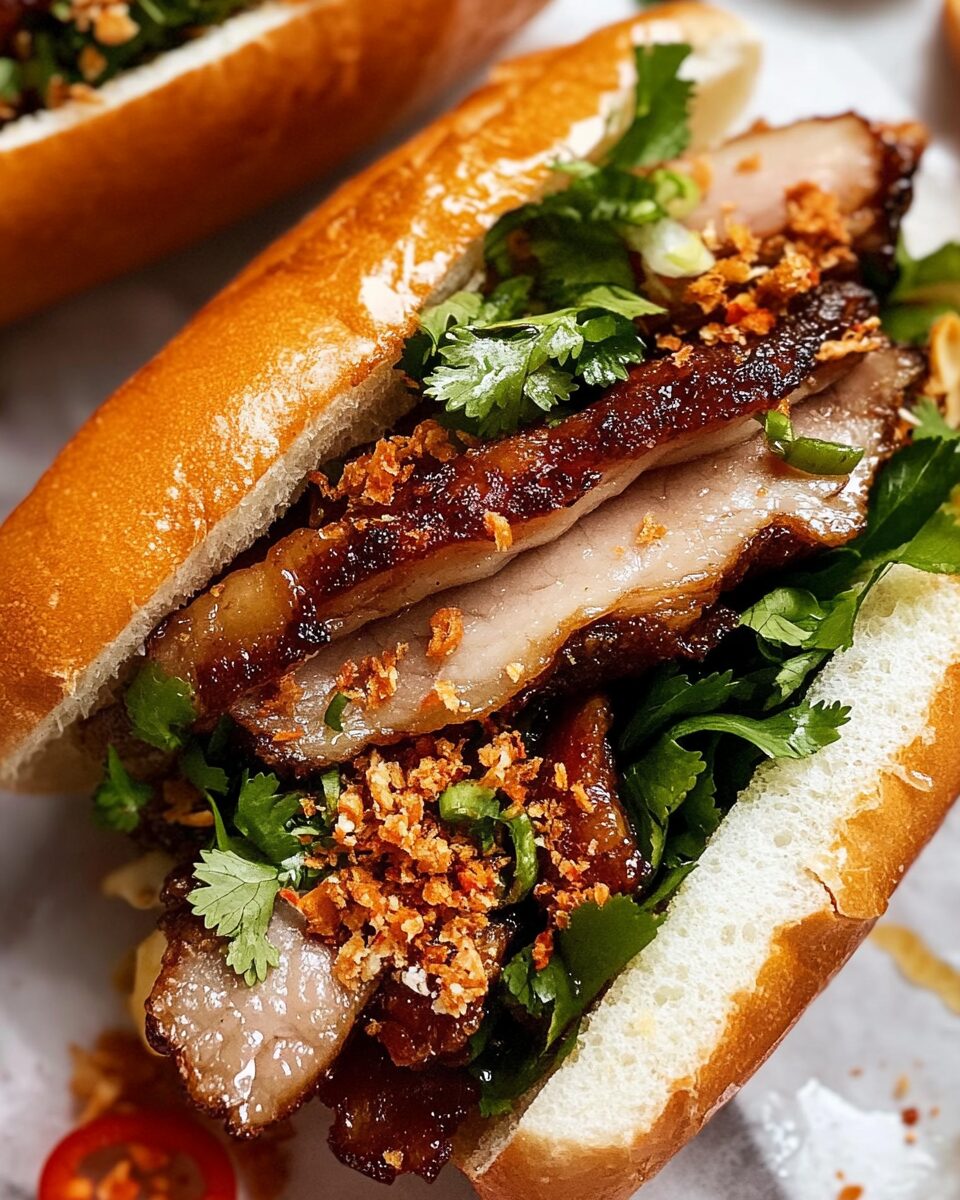The Crispy Pork Belly Banh Mi is a bold, flavor-packed Vietnamese sandwich that combines rich pork belly with ultra-crispy crackling, tangy pickled vegetables, creamy pâté, and a sweet-savory hoisin coconut sauce. All this goodness is tucked inside a perfectly crusty baguette, creating a sensory explosion with each bite.
Inspired by one of Melbourne’s most famous banh mi spots, this recipe elevates traditional street food into an unforgettable gourmet experience. While the pork may take some time to roast, every step is worth it—making this a perfect weekend treat or an impressive meal for guests craving something new, vibrant, and delicious.
Full Recipe:
For the Pork Belly:
-
1 kg (2.2 lb) pork belly with skin on (not scored)
-
1 ½ tsp vegetable oil, divided
-
½ tsp Chinese five spice (optional)
-
1 tsp kosher salt, divided
-
¼ tsp black pepper
Special Banh Mi Sauce (Ca Com Copy):
-
4 tbsp hoisin sauce
-
3 tbsp full-fat coconut milk
-
½ tsp dark soy sauce
To Assemble (for 5 rolls):
-
5 crusty white rolls (toasted)
-
120g (4 oz) chicken pâté
-
6 tbsp Kewpie or whole-egg mayonnaise
-
1 batch pickled carrots & daikon
-
3 green onion stems, sliced lengthwise
-
2 cucumbers, thinly sliced
-
2 cups cilantro (coriander) leaves and sprigs
-
3 Thai or Bird’s Eye chilies, sliced
-
8 tbsp crispy fried shallots (optional but delicious)
Directions:
-
Dry the pork skin: Place the pork belly uncovered in the fridge overnight to dry the skin. If short on time, pat dry thoroughly.
-
Preheat oven to 140°C / 285°F.
-
Season the pork flesh: Rub 1 tsp oil, ½ tsp salt, black pepper, and five spice into the flesh side.
-
Create a foil boat around the pork belly to hold the juices. Place pork skin-side up.
-
Season the skin: Pat dry again. Rub ½ tsp oil and remaining ½ tsp salt on the skin.
-
Slow roast for 2 hours. Tighten the foil after 1 hour as the pork shrinks.
-
Raise oven to 240°C / 465°F. Remove foil and use balled foil underneath the pork to level the skin for even crisping.
-
Roast for 30 more minutes, rotating as needed until crackling is deep golden and puffy.
-
Rest pork for 10 minutes, then slice into thick pieces.
-
Make the sauce: Mix hoisin, coconut milk, and soy sauce. Set aside.
-
Assemble the rolls:
-
Split rolls and smear bottom with 1.5 tbsp pâté.
-
Spread 1.5 tbsp mayo on top.
-
Add pickled veggies, cucumber, and green onion.
-
Pile on pork, drizzle with sauce, and garnish with cilantro, chili, and crispy shallots.
-
-
Serve immediately and enjoy while warm and crunchy!
Prep Time: 20 minutes | Cooking Time: 2 hours 30 minutes | Total Time: 2 hours 50 minutes
Kcal: 1313 kcal | Servings: 5
A Modern Take on a Vietnamese Classic: The Crispy Pork Belly Banh Mi
The Vietnamese banh mi is an iconic sandwich known around the globe for its perfect fusion of French and Vietnamese culinary traditions. At its core, it’s a vibrant mix of textures and flavors—crusty bread, creamy spreads, tangy pickled vegetables, fresh herbs, and rich meats. Among the many variations of this beloved street food, the Crispy Pork Belly Banh Mi has emerged as a gourmet favorite, celebrated for its indulgent twist on a classic.
This article explores the story behind this luxurious version, what makes it so compelling, and why it has found a permanent spot on both high-end bistro menus and food lovers’ home kitchens.
The Cultural Roots of Banh Mi
To understand the significance of this dish, it’s important to appreciate the history behind banh mi. The term “banh mi” simply means “bread” in Vietnamese, but it has evolved to describe the sandwich that has become a culinary symbol of Vietnam.
The sandwich is a product of French colonial influence—particularly the introduction of baguettes in the 19th century. Over time, Vietnamese cooks localized it by using their own ingredients: pickled carrots and daikon, fresh herbs like cilantro, and meats seasoned with fish sauce, soy, and other regional flavors. This delicious hybrid represents the intersection of East and West, history and innovation.
While traditional versions include cold cuts or “mystery pork” slices, modern variations have pushed the envelope by incorporating ingredients like grilled chicken, tofu, meatballs, and in this case, crispy pork belly.
Why Pork Belly?
Pork belly is celebrated in many global cuisines for its luxurious, fatty texture and the irresistible crunch it can deliver when cooked properly. In Vietnamese cooking, while not traditionally common in all banh mi variants, it has gained momentum thanks to contemporary chefs and food lovers who crave the extra indulgence and wow factor it brings.
What sets pork belly apart in this context is its ability to create a dramatic contrast of textures: succulent, juicy meat topped with shatteringly crisp crackling. This tactile combination heightens the eating experience and adds a layer of decadence to a dish that was originally designed to be quick and humble.
The pork belly version isn’t necessarily traditional—but it is authentic in spirit. Many vendors across Vietnam offer it as one of several filling options, especially in urban settings and at high-end banh mi cafes.
Crafting the Perfect Pork Belly
Perfecting crispy pork belly is both art and science. It requires patience, technique, and a clear understanding of fat rendering, skin drying, and oven temperature control. The pork belly needs to be dried overnight (or at least several hours) to ensure the skin will blister into a crisp layer during the roasting process. This step, often overlooked, is non-negotiable for achieving that signature crunch.
Additionally, it’s vital that the pork belly isn’t scored or pierced before cooking. Doing so can allow meat juices to escape onto the skin, sabotaging the crackling by turning it rubbery. Seasoning is kept simple—salt, pepper, oil, and optional five-spice powder—allowing the natural richness of the pork to shine.
The Role of Each Banh Mi Component
Though the pork belly is the undeniable star, a great banh mi is all about balance. Each element plays a strategic role in ensuring the final bite is not overwhelmingly rich, salty, or acidic.
-
The Bread: A crisp, airy baguette is essential. In Vietnam, the local baguettes are often made with a mix of wheat and rice flour, which gives them a lighter, crunchier texture than traditional French versions. Toasting the bread just before assembly ensures a perfect contrast to the juicy pork.
-
Spreads: This version honors tradition by using both pâté and mayonnaise. The pâté adds depth, a touch of iron-rich savoriness, and a nod to the sandwich’s French roots. The mayonnaise offers creaminess that pairs beautifully with the crispy pork and tangy pickles.
-
Pickled Vegetables: Carrots and daikon radish are pickled in a lightly sweet and sour brine, providing acidity to cut through the fatty richness of the pork belly. These pickles are not overly sharp, as they use rice vinegar, which has a gentler tang than Western vinegars.
-
Herbs and Fresh Additions: Sliced cucumber, green onions, and heaps of fresh cilantro introduce freshness, crunch, and color. A few slices of fiery chili elevate the flavor profile for those who enjoy heat.
-
Special Sauce: This recipe includes a rich, hoisin-based sauce blended with coconut milk and a touch of soy. It’s thicker than the usual Maggi seasoning drizzle and adheres to the pork better, enhancing flavor without softening the crackling—a small but genius upgrade.
Why This Sandwich Is Worth the Effort
At first glance, this banh mi might seem complex or time-consuming. After all, roasting pork belly and assembling so many elements isn’t typical for your average sandwich. But for those who love food and live for the sensory joy it can bring, this recipe is worth every moment in the kitchen.
Beyond its deliciousness, there’s something deeply satisfying about recreating a street food staple with such finesse. It offers an opportunity to connect with culinary culture while creating a meal that’s simultaneously comforting and luxurious. It also stores well, allowing you to prep the pork ahead and serve up sandwiches with minimal effort on the day of.
This version also feeds a crowd affordably. For about the same price as a couple of restaurant banh mis, you can make five generous, artisan-quality ones at home.
Perfect Occasions for Serving
This sandwich is perfect for:
-
Weekend brunches or lunches where you want to impress
-
Dinner parties with a DIY banh mi bar
-
Picnics or casual get-togethers
-
Street food-themed evenings with family or friends
-
Celebratory meals where you want comfort food with flair
It also makes a great introduction to Vietnamese cuisine for those unfamiliar with its flavors.
Tips for Success
-
Dry the pork skin properly – overnight in the fridge if possible. This single step guarantees a crackle to remember.
-
Level the pork belly during the final roasting to ensure even crisping. Uneven heat = uneven crackle.
-
Use good bread – crusty, not soft. The baguette’s structure is part of what makes each bite phenomenal.
-
Assemble right before serving – this preserves the contrast of hot pork, cold pickles, and crisp bread.
-
Don’t skimp on fresh herbs and chili – they brighten the richness of the pork belly beautifully.
Conclusion: A Sandwich Worth Mastering
The Crispy Pork Belly Banh Mi is not just a meal—it’s a culinary celebration of texture, contrast, and culture. While rooted in Vietnam’s vibrant street food scene, this gourmet version elevates the experience to new heights with rich, slow-roasted pork belly and thoughtful assembly.
It invites you to slow down, savor the process, and enjoy food in its fullest expression—from the crackle of the pork to the tang of pickles, the creaminess of pâté to the crunch of the bread. Whether you’re a longtime fan of Vietnamese cuisine or someone new to it, this recipe is an exciting gateway into one of the world’s most beloved flavor combinations.
It reminds us that the best meals aren’t always the fanciest—they’re the ones made with care, intention, and a genuine love for food. And in the case of this banh mi, each bite proves just that.





